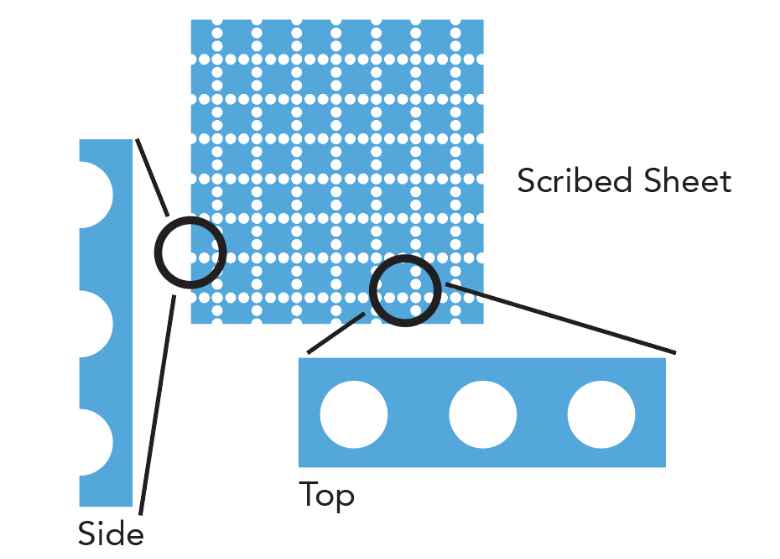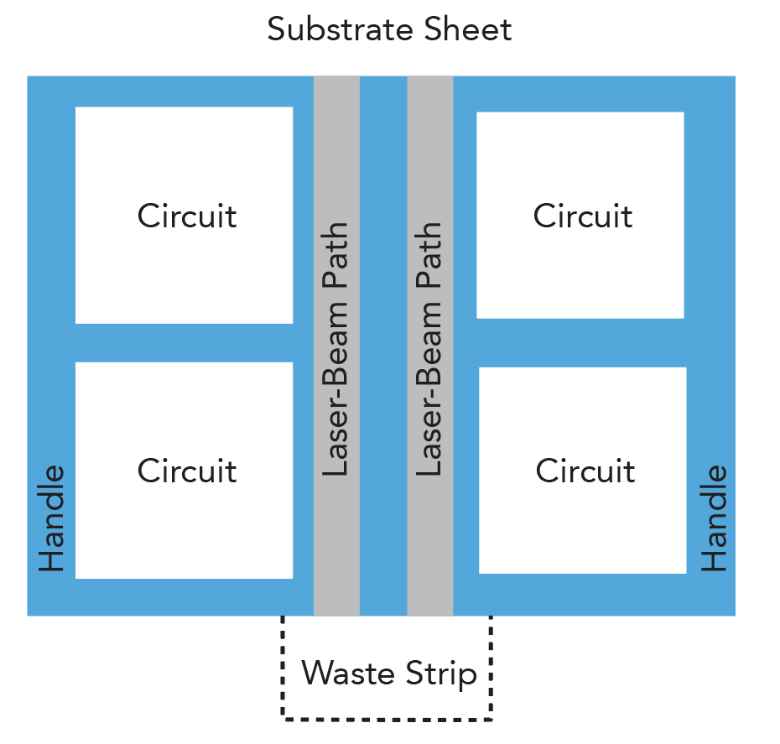5 Keys to Successful Laser Processing of Ceramic Substrates
Contents
Introduction
Choice of ceramic materials, circuit layouts, and singulation methods are key to achieving the required cost, fabrication time, size, weight, and yield of your laser-processed microelectronics substrates.
When it comes to shaping, drilling, and singulating circuit ceramic substrates, lasers offer key advantages compared to other methods, such as mechanical dicing (with a saw or die), water jetting, and mechanical drilling. But leveraging those advantages is not as simple as just deciding to employ a laser. Choices about how the substrate will be laser-processed and the material choice itself greatly impact circuit layout and thus fabrication time, size and weight, yields and profitability.
Getting to Know The Power of the Laser
Lasers offer greater precision than water jetting and mechanical dicing in that they can typically cut to within ±.002” of a circuit element or feature, depending on thickness. That’s compared to ±.010” to .015” with water jetting, ±.003” with a synthetic diamond saw, or ±.005” with die cutting — so circuits can be much smaller when laser-processed and more tightly packed on a single sheet of ceramic material. The ability to produce smaller and more densely packed parts means the cost per part will be lower, fabrication will be faster, and the yield of smaller parts will be higher.
Laser-scribed ceramics, which are mechanically “snapped” during singulation can have circuits that are packed the tightest but there are disadvantages which we’ll explore below.
Lasers can also drill smaller diameter vias than mechanical drills—down to .003” for lasers vs. .020” for mechanical drilling. However, unlike holes drilled mechanically, whose walls are straight, the walls of laser-drilled holes will taper so that the diameter of the hole at the beam’s exit point will be smaller than the diameter at the entry point, typically correlating to 10% of the thickness of the material. Smaller tapers can be achieved with a slightly longer focus lens.
An important advantage over mechanical die cutting is that lasers avoid the expense of making a die, which can be thousands of dollars. Not only are dies expensive, but the time needed to make a die can be days or weeks longer than the time needed to set up a laser—so fabrication time is considerably less with laser processing. And if fabrication requirements ever change, the expense and delay of making another die must be incurred all over again.
Once a circuit designer understands lasers’ inherent advantages, they can exploit those advantages to their maximum potential by controlling key variables involved in the laser process. These include singulation method (cutting vs. scribing), the order of laser-processing steps, circuit layout, and choice of materials. These variables are highly dependent on each other, so decisions affecting one often involve tradeoffs affecting one or more of the others—leaving designers to choose their priorities.
Ceramic Processing
Here are the 5 Best Practices for Laser Processing Ceramic Substrates:
1. Know when to laser scribe or laser cut when singulating
The decision of whether to cut or scribe often comes down to whether the application can accept a scribed, or perforated, edge. To scribe, the laser does not cut the material all the way through but instead pulses a line of tiny holes into one surface, with minute strips of material between the holes (see Figure 1). Once the entire sheet has been scribed, the parts can be singulated by breaking the sheet along the perforations, leaving single parts, which will have edges that will appear jagged if viewed under magnification.

Figure 1: Scribing’s jagged edge
Unlike laser cutting, where the laser singulates parts from a sheet of substrate material by cutting completely through the sheet, in scribing the laser beam only goes part way through as a series of pulses that produce round holes that are visible under magnification. Individual parts are then singulated by mechanically breaking the sheet along the scribe lines. Scribing takes less time than cutting.
So, one advantage of cutting, then, is that it produces a clean edge, which scribing does not. Another advantage is greater precision. The minimum distance from a cut line to a feature is .002” versus a minimum of .005” for a scribe line. That difference is largely due to the way the parts are separated from each other. (This advantage is often lost, however, when kerf considerations are made as explained below. But are gained back again when considering that manual snapping is inherently plagued by unwanted cracking and can’t be done on a curve.)
So, if having a clean edge, a curved edge, or a narrower edge around the part is a priority, cutting is likely to be the singulation method for you.
But cutting also has disadvantages the designer should consider. One is that laser cutting takes longer than scribing because the laser is cutting completely through the substrate, which likely also increases fabrication cost. Yield—i.e., the number of parts that come from a single ceramic sheet—is also lower with cutting. That is because more power is required to completely cut through the substrate, which means the laser beam is wider (i.e., its kerf is larger), so parts must be farther apart. The path the beam takes between the parts—called a “waste strip” or “street”—is also wider for thicker substrates, since thicker substrates take more power to cut through. As a rule of thumb, the distance between cut features must be at least the thickness of the material, or greater. (see Figure 2). That also means that the thicker the substrate, the fewer the number of parts that can be cut from a single ceramic sheet. Some designers may find that to be a necessary tradeoff, however, like when their application requires a more rigid part.

Figure 2: Cut vs. kerf
The more material the laser has to cut through (because the substrate is thicker) the wider the kerf (the distance between parts). That’s because thicker substrates require more powerful (hence, wider) laser beams in order to cut through them. That means more circuits can be packed onto thinner substrates; however, thinner substrates are also less rigid.
But not only is yield less when cutting because the cutting path is wider; yield is also less because the number of passes the laser beam makes between adjacent parts is doubled. (see Figure 3). In other words, the laser can’t make a “clean cut,” or just one cut to singulate two adjacent circuits on the substrate—two cuts are needed. That is because the width of the beam is based on the power needed to cut through the substrate. Cutting to within the required tolerance on one side of the path will leave too wide an edge on its neighbor “across the street.” So the laser beam must make another pass to remove that excess material. The material must also be wide enough to provide a “handle” to hold the part while the material is being cut off, leaving even less ceramic real estate available for the circuits. Obviously, the need to make two passes with the laser for cutting also increases processing time. Consult your laser job shop design team to assist you with early stage circuit layout to minimize the number of passes. In some cases, single passes can be achieved.

Figure 3: Success at the margins
A key cost metric is the amount of substrate material that ends up in the product versus how much ends up being discarded. Because it leaves a very clean and precise edge (not jagged) after singulation, laser cutting has an advantage over scribing in that the cut can come very close to a circuit without damaging it. But because the space (“waste strip”) separating adjacent parts on the sheet is much wider than the beam, the beam must make two cuts—one on each side of the waste strip. That ensures that the amount of substrate left surrounding all singulated circuits is the same. Material is also lost to the “handle”—i.e., the excess substrate required to hold the sheet in place during singulation.
Note: Ask your laser job shop about their laser enclosure gas management skills. An advanced shop will be able to communicate their capacity to create the right atmospheric balance of carbon dioxide, helium, and/or nitrogen for the material and avoid chips and cracks.
2. Know when to metalize
The sequence of three key fabrication steps—via drilling, singulation, and metalization—also has a big impact on the cost and time required for laser processing. Obviously, the more times the same parts must visit the laser processor the greater the overall time and expense involved. The critical choice here is whether the circuit will be singulated before it is metallized. If metalization comes last then any via holes can be drilled and the substrates singulated in just one visit to the laser processor. If sheets are metalized prior to singulation, however, that may require two visits—one visit to drill the vias so that they are available to connect circuit paths, and then a second visit to singulate parts after metalization. But singulation itself also takes longer if the parts are pre-metallized. That’s because sheets must be processed individually rather than in batches, due to the extreme alignment challenges of cutting or scribing multiple sheets in parallel.
This potentially costly situation can be avoided by choosing the right laser processing manufacturer. Experienced laser manufacturers, such as Accumet, have built relationships with strategic plating vendors to handle all three key fabrication steps in-house. This saves time and cost while keeping an excellent production quality. To ensure quality and yield choose a laser job shop that uses machine vision cameras and part rotation software at the alignment stage.
3. Know your circuit-layout limitations
By far the one variable that most determines method of singulation and order of processing steps—and thereby most correlates to laser-processing cost and turn time—is circuit layout. It’s also obviously the one variable most under the control of the circuit designer. Circuit layout determines the proximity of circuit elements to regions where they would be harmed during singulation, either by heating during cutting or by cracking during scribing and snapping. Likewise the decision of when to metalize a part may be driven by where to place key elements on the substrate.
Another layout parameter over which circuit designers typically have control is the clearance around the area where the laser will punch through when drilling vias. In general, there should be at least 0.003” clearance so that a potential slag bump or chip will not damage nearby features.
Clearance is also a factor in planning the radius of curves. A key advantage of using a laser is the ability to cut virtually any shape. However, ceramics are brittle and can chip. To reduce the chance of chipping a feature, designers should consider a “safety zone” around inside corners with at least 0.005” in radius. Rounding outside corners also reduces chips.
Understanding the impact of these layout decisions, perhaps in collaboration with the laser-processing expert, is therefore key to achieving design goals.
4. Choose the right substrate for the job
Most popular ceramic substrates for microelectronics, and alumina 96% is by far the most popular at 90% of the circuits in production today.
- Alumina 96%
- Alumina +99%
- Beryllium Oxide, BeO
- Aluminum Nitride, AlN
But what about the other 10 % of ceramics? Here’s what you might overlook.
The reason alumina +99% might be your best option is that it offers a superior surface for fabricating thin-film circuitry. On the other hand, where high-heat conductivity is required, designers may choose beryllium oxide (BeO), or aluminum nitride (AlN), which offers slightly less heat conductivity than BeO, but is much easier to handle.
Note: In addition to the main substrate material, designers should also take into consideration their surface or embedded material choices. These materials can complicate fabrication, adding processing time and expense. Surface metals, for example, tend to reflect laser energy and can possibly cause slight changes in the kerf. The laser can also cause the metals on the backside of the substrate to melt, meld and bead. Glass also has a tendency to chip when laser cut, especially on the exit side of the laser beam. And polymers may melt when the laser beam gets within 0.005”.
5. For Best Results—Design to Fabricate
The best advice when contemplating a new microelectronics circuit design is to factor fabrication issues into the design ahead of time. Very often simply relocating a feature on the substrate or substituting one material for another can make all the difference between whether the part can be fabricated at reasonable cost or not. Breakthroughs in laser fabrication are also happening every day—and very often designs that were impossible to fabricate a few years ago can now be fabricated reliably with current methods.
Conclusion
The best way to compare laser-processed ceramic substrates to more traditionally processed ceramic substrates is on the basis of your own product and production requirements. Are you looking for high-precision cuts so that your circuits can be smaller and more tightly packed? Do you know if your substrate needs to be cut or scribed? Have you discussed your fabrication needs with a manufacturer prior to design? If you’re uncertain about a design feature’s capacity to be fabricated contact us or upload a drawing on our support page.

